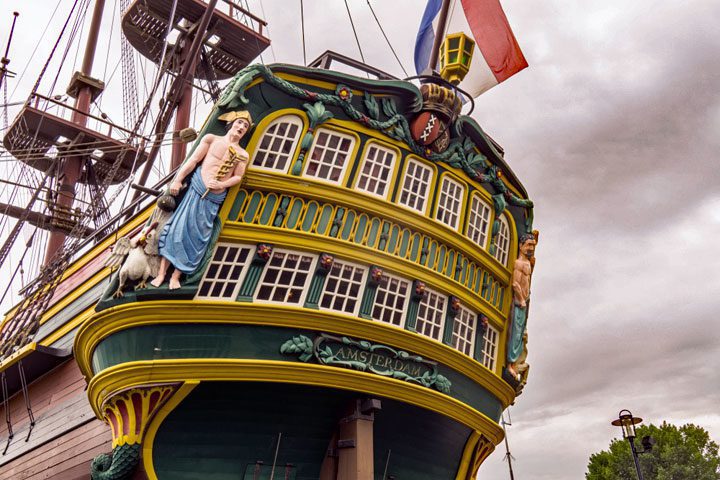The Netherlands – Siam, a piece of history

By Josh on the Dutch Wikipedia, CC BY-SA 3.0
Siam, Ratcha Anachak Thai, or Muang Thai, -land of the free people- is the official name of the country that has been in existence since 1939. Thailand is called. In the 17e in 18. e century there was a close bond between Siam and the Netherlands and there were good trade relations between the two countries.
It all started on November 7, 1601, the day on which two Dutch ships, the 'Amsterdam' and the 'Gouda', commanded by Jacob van Neck, moored in Pattani in the south, close to Songkla. The place was 'tributary' to Siam at that time. Portuguese, Chinese and Japanese had already acquired a place there at that time. It will be clear that the arrival of the Dutch ships was not exactly welcomed by them.
Factory
Despite this opposition, our compatriots concluded a trade agreement with the Queen of Pattani to buy pepper, among other things, under favorable conditions. Within a year, in 1602, a so-called 'factory' was built where the merchants Pieter Walliechsz van Delff and Daniel van der Lecq settled with a number of followers. Soon this trading office took on a significant role and it was even thought that Pattani could be a kind of gateway overland for trade with China and Japan.
In 1604 the 'Oppercoopman' of the VOC Cornelis Specx with precious gifts to the Siamese court, hoping to gain important trade advantages. The Siamese king also valued good relations with the Dutch and sent a delegation to the then Stadtholder Prince Maurits. The Siamese legation, the first ever sent to Europe, arrived in the Netherlands on the 'Oranje' and was received in audience on 11 September 1608 by the Stadholder.

Laurens Hoddenbagh / Shutterstock.com
Ayutthaya
We have arrived in 1627 when the king of Siam allows the VOC to build a stone building in Ayutthaya may establish. Trade flourishes and the chief of the factory is given the rank of Mandarin by the monarch, with great powers as 'sonderling proffyt for the Generale Compagnie'. Because there was a great shortage of rice in the Indies, there was interest in supplementing that from Siam. To please the Siamese monarch, the Dutch helped him when Siam was hit by 'domestic or foreign' strife.
In the middle of the 17e century, the Greek adventurer, Constaat Phauleon, gained great influence over the king of Siam and turned him against the Dutch, who soon began to suffer from this. By order of Batavia, the VOC left the factory in Ayutthaya and blocked the Menam river, causing much damage to trade for the king of Siam. Funny is the origin of the name Menam for the largest river of Thailand, the Mae nam Chao Phraya. The Thai name for river is Mae nam. At that time, the Dutch of the VOC trading post thought that 'Mae nam' was the proper name of the river, which is why even on old maps the river is referred to as Mae Nam.
The Dutch Foolishness
Very soon after the blockade, the king sent a delegation to Batavia. If we consider the VOC as a Western power, this resulted in the very first treaty that Siam concluded with the West. The Dutch – Siamese trade flourished again, but never again reached the size that previously made the factory of Ayutthaya a 'profitable office'. Gradually, the staff in Siam was reduced and the Siamese Court refused to continue to give the Dutch the trade monopoly. In 1768 the factory in Ayutthaya was closed.
All this took place during the Republic of the Seven United Netherlands (1588-1795), a state that never had more than two and a half million inhabitants and was incredibly important in international trade. According to a newspaper report from 1934, the debris of the ruins of the Dutch factory building was overgrown with trees and plants in that year.
Until around 1930, near the mouth of the Menam, or Mae nam Chao Phraya river, there were still the last remains of the old fortified company warehouse 'Amsterdam', which bore the telling name among the local population: De Hollandse Dwaasheid.


Nice story about the VOC, I went a little further and on Wikipedia you can read much more about the VOC in Siam/Thailand. It is all neatly described what those respectable merchants have achieved, but of course not everything went so smoothly. The men did not shy away from a murder, looting, hijacking of a ship, rape. The English and Portuguese were no better, you know, it was just the way it was in those days. I would have really liked to have experienced it, as a dignitary, that is, ha, ha!
Today's Asia is almost inconceivable without the enormous influence that the Dutch have had through the VOC. (And still arouses the envy of the British!) In addition to the history of the factory in Ayutthaya, one can also think of the "Sterkte" (kind of fortress) on Phuket and of course the journey from Wusthof around 1641 across the Mekong to Vientiane, among others. .
In the 19th century the figure of Duyshart, who was taken by the French for an Englishman, was a cartographer in the service of the King of Siam.
And who remembers that the Hualamphong main railway station in Bangkok was built by Dutch architects and engineers.
Curious, by the way, that many European explorers report badly on the natives; stupid, lazy, unreliable. Others are much milder and talk about the gentleness of the people, but laziness remains a constant.
It's a pity that our history education is so bad, sometimes it seems as if there is only a "get rid of us" mentality.
Amusing,
The commemorative plaque was made by the Groningen sculptor M.Meesters.